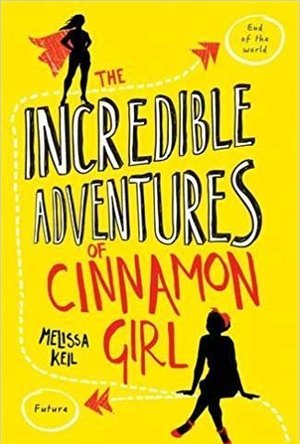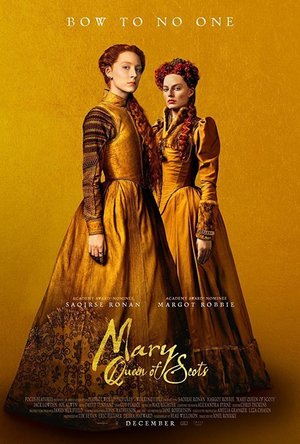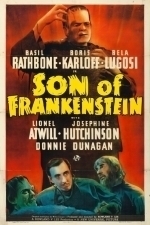Louise (64 KP) rated The Incredible Adventures of Cinnamon Girl in Books
Jul 2, 2018
The Incredible adventures of Cinnamon girl takes place in a small town in Australia, nothing ever happens in Eden Valley until one day a YouTube video goes viral. Ned Zebidiah has predicted an apocalypse and the only safe haven is the one and only Eden Valley.
17-year-old Alba loves her little town in Australia where nothing much happens, however she is at a stage in her life when she needs to make decisions, life changing ones. Alba wishes everything could remain the way it is, her friends and family all in one place as she likes it. Her friends on the other hand have different ideas, the majority of them cannot wait to say goodbye to Eden Valley and see more of the world. With an impending apocalypse, the return of an old friend and decisions to be made, can Alba keep it together?
I really like Alba's character, she is artistic, witty and loveable. She is at the stage of her life when she has just finished school and she has to make decisions about what to do with her life, should she go to college? work? travel? Alba also has curves and a healthy figure which is portrayed in this story really well, there is no self-consciousness with the way she looks, she is confident and it's so refreshing to see this in a YA book especially as the younger audience are so impressionable. Alba also loves to draw and Cinnamon girl is her creation, drawing frame after frame trying to get her image right or the background just so. I have recently started being interested in comics and I loved the idea of someone creating them and the illustrators thought processes. Alba was a great strong protagonist and very relatable.
Grady is Alba's best friend in the whole wide world they have grown up and done everything together. Grady has his flaws like most of the characters in this book but he is such a nice boy, knowing what he wants to do with his life and being there for Alba giving her encouragement with her drawings of Cinnamon girl.
One character I didn't like was Daniel, he just appeared to be egotistical, very self-conscious and a bit of a sleaze. With masses of people flocking to the safe have of Eden Valley, Daniel returns years after moving away and has become a bit of star in TV and is stirring a lot of emotions within Alba and Grady.
This book is so cute, it has a slow burn romance with no love triangle, the writing style is amazing and loved that it was set in Australia. I really like that the book incorporated comics and a few famous comics/names were mentioned such as Fiona Staples and Persepolis. This was my first Melissa Keil novel and have been recommended life in outer space
I recommend this book to anyone who reads YA with a slow burn romance, art/comic content.
Overall I rated this 4 out f 5 stars.
Lucy Buglass (45 KP) rated Mary Queen of Scots (2018) in Movies
Jun 20, 2019
The performances given by both Saoirse Ronan and Margot Robbie are just stunning. Between them, they carry the entire film and transport you to another time and place. They’re captivating and powerful, particularly Ronan as Mary. I loved her character and felt invested in her. Despite knowing how it was all going to end I still rooted for her throughout, and wanted her to succeed. Her character is driven, passionate and tenacious, traits that Ronan truly brings to life on screen.
Aesthetically, Mary Queen of Scots is a wonderful film that is picturesque even during the darker scenes. Both leading ladies pull off the roles and the costumes effortlessly. I’ve never been so impressed by hairstyling in particular, so I would love this film to win the Academy Award for Best Makeup and Hairstyling this year. The styles were so intricate and beautiful, bringing out the personalities of those who wore them.
It is also refreshing to know the film was directed by a woman, considering the narrative focuses on two of history’s most powerful and intriguing queens. This was actually Josie Rourke’s directorial debut, and what a fantastic one it was. I loved the way she portrayed all the ugliness of life in this era, just as much as the regalness. There is one scene where Mary is shown on her period, and this really struck me. I liked how it was normalised, no one made a big deal out of it, it was just a part of her life like every other woman. I’m glad Rourke chose to include this.
As many people have pointed out, this film is certainly not historically accurate so if you’re the kind of person who needs that you’d leave feeling disappointed. For me, I saw it as an interesting case study of both women that’s a work of fiction. That’s alright in my books and I don’t have a problem with artistic licence. It was an entertaining period piece that was beautiful to look at. Sometimes that’s enough. Nobody was trying to suggest this was a documentary, it’s a film.
Overall Mary Queen of Scots is entertaining and very well acted, but the narrative does feel a little too slow and drawn out in places. It’s definitely not the strongest period piece I’ve seen, but that doesn’t necessarily make it a bad film. It is worth seeing on the big screen due to the beautiful Scottish scenery and the intense conflict between Protestant and Catholic. It’s bold, dramatic and worth losing yourself in, even if you’d only do it once.
https://lucygoestohollywood.com/2019/01/23/a-tale-of-two-queens-my-review-of-mary-queen-of-scots/
Hazel (1853 KP) rated The Joyce Girl in Books
Dec 14, 2018
Winner of the Impress Prize for New Writers 2015, Annabel Abbs creates a fantastic work of historical fiction based upon the life of Lucia Joyce. Although the titular character may be unheard of within the general public, her father will be known amongst the majority of readers. James Joyce, the eccentric author of<i> Ulysses</i> and <i>Finnegan’s Wake</i>, travelled around Europe with his family until settling in Avant-garde Paris, 1928. His daughter, Lucia, an ambitious, talented dancer describes the unconventional life as a child of Mr. Joyce, its ups and downs, and inevitable ruinous breakdown.
<i>The Joyce Girl</i> begins in Küsnacht, Zurich where Lucia is receiving treatment from Dr. Carl Jung – another well-known name; this novel is full of them. Struggling to come to terms with her current mental ill health and supposed repressed memories, Jung encourages Lucia to write her memoirs in order to learn of the events that led to this current predicament. Starting from 1928, aged 21, Lucia describes her life to Jung and the reader in brutally honest detail.
The unusual Irish family went through various successes and traumas in the intervening years, creating a humorous and emotional story. Lucia’s brother, Giorgio, caused the family enough problems without adding in the devastating heartache Lucia suffers from men who do not reciprocate her love. One of these lovers is the famous Samuel Beckett (<i>Waiting for Godot</i>, 1952), the first man Lucia falls for. It is fascinating to learn of the multiple connections these notable names had with each other. Although in retrospect it makes sense that the literary and artistic crowds would stick together.
From Lucia’s memoirs Jung formulates that the Joyce parents were extremely controlling, not giving Lucia the opportunity to live her own life – particularly within her dancing career. However, Jung still maintains that Lucia experienced emotional trauma and is insistent on retrieving those memories. What he eventually discovers will shock and possibly sicken the reader.
Through enormous amount of research, Annabel Abbs has put together a likely account of the Joyce family, particularly Lucia’s life. Using existing biographies, original letters and professional opinion, Abbs devises a logical narrative for the unfortunate dancer. Drawing upon knowledge of other literary greats and artists of the era, <i>The Joyce Girl</i> can be easily believed to be a true account, although doubtlessly some scenes must be based upon imagination.
<i>The Joyce Girl</i> will attract historical and romantic novel enthusiasts, providing an enjoyable, thought capturing story, as well as an opportunity to learn. Whether you are aware of James Joyce’s works, or even Lucia herself, <i>The Joyce Girl</i> is bound to capture your attention and draw your mind into the European life during the early 1930s. Although only her debut novel, Annabel Abbs comes highly recommended and it will be interesting to see what direction she has decided to take in her shortly expected second novel.

Smarty Shortz 1st Grade
Education and Games
App
Finally, an awesome, interactive, learning tool designed for your grade school Smarty! This...
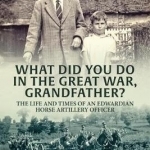
What Did You Do in the Great War, Grandfather?: The Life and Times of an Edwardian Horse Artillery Officer
Book
Part history, part social documentary, part love story, this is a grandson's search for what his...
Matthew Krueger (10051 KP) rated Son of Frankenstein (1939) in Movies
Oct 9, 2020
The plot: Baron Wolf von Frankenstein (Basil Rathbone) is determined to prove the legitimacy of his father's scientific work, thus rescuing the family name from disgrace. With the help of Ygor (Bela Lugosi), a grave robber, Wolf successfully reanimates the monster (Boris Karloff) his father originally brought back from the dead. But when several villagers are killed mysteriously, Wolf must find the culprit in order to vindicate his creation, or face the possibility that he may be responsible.
Universal's declining horror output was revitalized with the enormously successful Son of Frankenstein, in which the studio cast both stars.
After the ousting of the Laemmles from Universal and the British embargo on American horror films in 1936, Karloff and Lugosi found themselves in a career slump. For two years, horror films were out of favor at Universal Studios. On April 5, 1938, a nearly bankrupt theater in Los Angeles staged a desperate stunt by showing Frankenstein, Dracula and King Kong as a triple feature. The impressive box office results led to similarly successful revivals nationwide. Universal soon decided to make a big-budget Frankenstein sequel.
Son of Frankenstein marks changes in the Monster's character from Bride of Frankenstein. The Monster is duller and no longer speaks, explained by being injured by a lightning strike. The monster also wore a giant fur vest, not seen in the first two Frankenstein films, perhaps to add color to his appearance when the film was planned to be shot in color. He is fond of Ygor and obeys his orders. The Monster shows humanity in three scenes: first when he is disturbed by his image in a mirror, especially when compared to the Baron. Next, when he discovers Ygor's body, letting out a powerful scream, and later when he contemplates killing Peter but changes his mind. While the first two films were clearly set in the 1900s, this film appears to take place in the 1930s, judging by the appearance of a modern automobile.
Peter Lorre was originally cast as Baron Wolf von Frankenstein, but he had to leave the production when he became ill. Replacing Lorre was Basil Rathbone, who had scored a major triumph as Sir Guy of Gisbourne in The Adventures of Robin Hood, released the previous year.
According to the documentary Universal Horror (1998), the film was intended to be shot in color and some Technicolor test footage was filmed, but for artistic or budgetary reasons the plan was abandoned. No color test footage is known to survive, but a clip from a Kodachrome color home movie filmed at the studio and showing Boris Karloff in the green monster makeup, clowning around with makeup artist Jack Pierce, is included in the same documentary.
Its a excellent universal monster film.

Portraiture - face makeup kit to retouch photos and beautify your portraits!
Photo & Video and Utilities
App
Professional skin retouch, keeping the details and without losing texture! All operations made...

Punchbowl – Online Invitations
Lifestyle
App
Create, personalize and send beautiful invitations on the go for FREE with Punchbowl®, the new gold...

Split Pic Photo Collage Editor
Photo & Video and Entertainment
App
The (new and improved) Original Collage & Cloning App with over 50 MILLION satisfied users! Split...
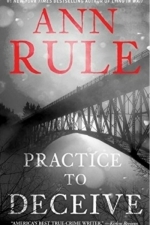
Practice to Deceive
Book
#1 New York Times bestselling author and Queen of True Crime Ann Rule delivers another gripping...
True crime murder
